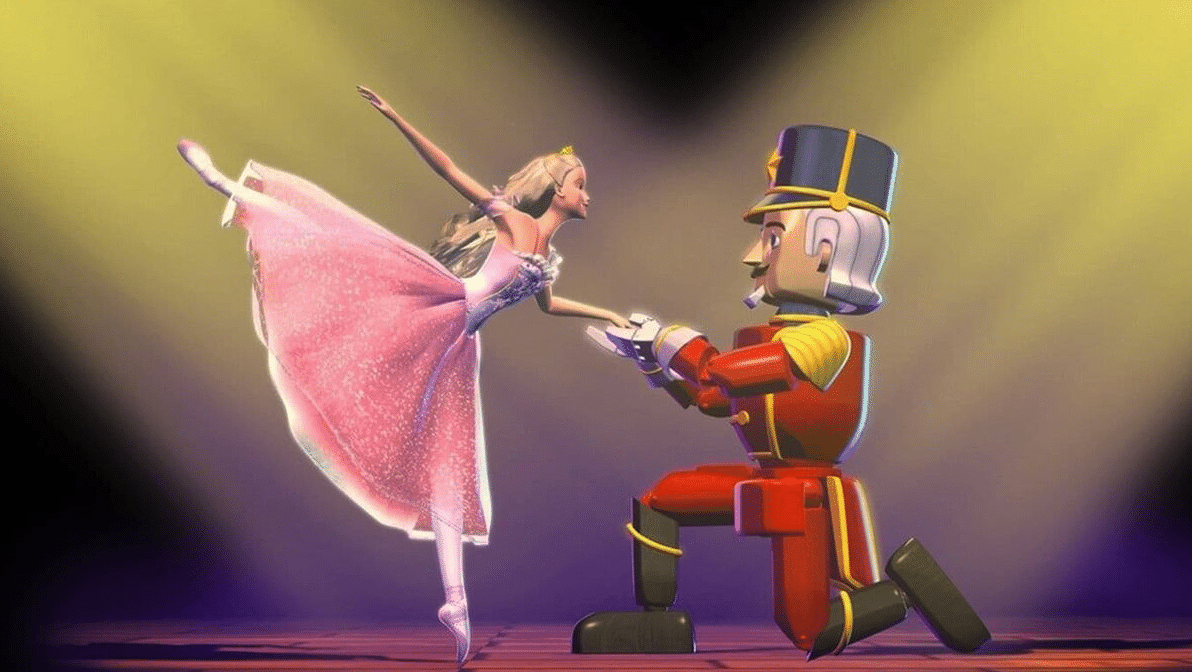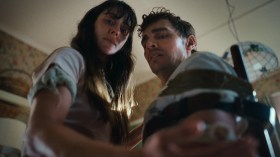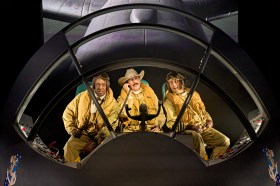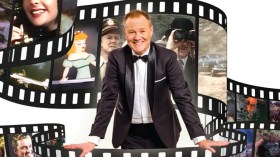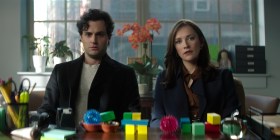It would be a waste of time to tell you that Barbie is having a major cultural moment – especially given that enough of us turned out for Greta Gerwig’s Barbie film on it’s opening weekend for the film to earn US $377 million, making it the largest debut ever for a film directed by a woman.
Gerwig’s Barbie captures the Malibu-esque pink polyvinyl Void according to Mattel – everything is shiny and clean and bright, and various different Barbies wave vacantly at each other from Don’t Worry Darling dreamhouses, whilst having Perfect Days that never end.
Barbie’s pink purposeless void can be explained away by the fact that she doesn’t have ‘lore’ – Barbie wasn’t born and therefore didn’t grow up, she doesn’t have a ‘canon event’, she doesn’t have an Uncle Ben who died as a result of her shirking responsibilities. She has every job and therefore she has no defining career.
In her own words, Gerwig’s Barbie says: ‘I’m Stereotypical Barbie. I’m the Barbie everyone thinks of when they say, “Think of a Barbie!”‘
The thing is: I don’t recognise this Barbie at all.
I don’t mean that in a philosophical way. I mean, Barbie the Existential Margot Robbie Doll is not the first thing I think of when I picture Barbie. I think of this Barbie:

This is the Barbie of Mattel’s ‘Straight to VHS, then later DVD, then even later streaming’ empire, which she rules over with an animated fist.
She once lived, not in a dollhouse, but in the Weekly section of your local Blockbuster throughout the noughties. Where Margot Robbie’s Barbie glides on raised heels, this Barbie plods jankily through a CGI Uncanny Valley wasteland.
Read: Barbie review – this Barbie will bust the block
Between 2001 and July 2023, 42 animated Barbie films were produced. That’s an average of two Barbie films a year, resulting in millions of dollars in revenue. You might have seen some of these titles before, maybe on a child’s backpack or lunchbox, but you’d be forgiven for glazing over at the sight of yet another glittery pink product that will inevitably sparkle in a glorious pile of landfill.
From Barbie and the Nutcracker, to Barbie Fairytopia, to Barbie and the Three Musketeers – it’s a sprawling, multimillion-dollar franchise that has had almost zero lasting impact on Barbie as a character and brand. There wasn’t even a faint nod to this series in the latest Gerwig flick, even among all of the cameos of little-remembered dolls (such as Ken’s Friend Allan, and Midge the pregnant Barbie with removable fetus).
Read: How Barbie reimagines a childhood icon through a feminist lens
Here are some of the elements of the Barbie Cinematic Universe, as experienced by that floating generation between Generations Y and Z, born at the end of the 90s.
Barbie and the Easily Digestible Platitudes
Excusing a couple of examples, the Barbie films are not sequels to each other. They each are their own individual story that Barbie is merely an actor in – some being original plots but most being adaptations of famous children’s tales. Many of them have follow the same basic formula:
- Barbie’s little sister Kelly (later Chelsea) is upset about something (She can’t paint as well as Barbie can, or she doesn’t feel ready to dance at a Christmas themed ballet recital, etc.).
- Barbie will begin to tell Kelly a story that relates to the situation vaguely (such as Rapunzel, or the Nutcracker).
- We watch the story play out, and the main protagonist in the story looks exactly like Barbie (but it’s definitely not Barbie, it’s Rapunzel, or Clara from the Nutcracker, it just looks like Barbie).
- In this film, Barbie’s protagonist would have One Significant Talent (such as painting, or singing, or looking at geodes, for some reason).
- We wrap up the film with Kelly learning a lesson (such as, Christmas is good, and painting requires practice).
- At some point, it’s revealed that Barbie’s character is a Princess. This is inevitable, regardless of story or setting.
The rights to Barbie have been divided over several animation production companies and distributors over the last 20 years, not unlike to the many studios that have divided up rights of Marvel and DC characters. After 2010, Mattel Entertainment was replaced by Barbie Entertainment, reflecting the shift from adaptations of classic fables to more modern settings and plots.
Barbie and the Magic of Mocap Ballet
Growing up in the early noughties, as I did, Barbie and ballet were synonymous. The very first Barbie movie was an adaptation of The Nutcracker ballet, featuring the London Symphony Orchestra playing the original score by Tchaikovsky. Barbie and the Nutcracker used a fairly new CGI motion capture technology, recruiting members of the New York City Ballet to wear dotted suits and bring the story to life.
This technology resulted in a clunky product, but also in characters that felt tangible, almost as though they had physical mass. Sure, sometimes a dancer’s perfect arch would occasionally look like Barbie had a severely broken ankle, but this was all part of the charm and the magic of ballerina Barbie.
This style of animation would go on to be used in future Barbie iterations, such as Barbie of Swan Lake and Barbie and the Twelve Dancing Princesses.
Barbie and Bibble (and other terrifying sidekicks/villains)
The BCU has lived on in an almost-fandom, mostly comprised of memes about the poorly animated side characters and villains featured across the scores of animated films. In particular two characters have stood out: Bibble the pet ‘puffball’ from Barbie’s Fairytopia series (2005-2008), and Preminger, the flamboyant villain of Barbie’s Princess and the Pauper (2004) voiced by Martin Short.
Barbie and the Reasons Why We Didn’t See DVD-Barbie in Gerwig’s Feminist Celebration
It’s easy to look back on this version of Barbie with cynicism. Are these films a cheaply produced cash grab designed to produce more merchandise for Mattel, mostly directed by men, and which serve only to further Barbie’s image as a devastatingly pink, thin, and Caucasian product mostly pushed to the middle class? Yup.
You can apply the same critiques to most major franchises directed to kids, from Disney princesses to superheroes – and that analysis is appropriate, and much needed. But, as Gerwig’s film summarises in a much more elegant way, even though Barbie’s legacy will always be clouded by her shortcomings, generations of children have loved Barbie wholeheartedly for her potential, and celebration of all things stereotypically ‘girly’.
Gerwig masterfully walks the line between a full blown satire and a genuine celebration Barbie. Her script is whip smart, and her portrayal of the iconic blonde is nuanced and allows for a three dimensional character to emerge.
The straight to DVD Barbie films are not even close to this. Perhaps the reason these films didn’t get a nod in the recent adaptation is because they are completely too sincere. There isn’t any reflection on Barbie the Doll, or even Barbie as a character. There’s nothing meta or fourth-wall breaking about them, no inside jokes for parents sitting beside their children.
The closest DVD-Barbie gets to being self aware is the occasional ‘blooper reel’ in the credits, but even these are extremely sanitised. It’s possible these films have done more to confuse us about who Barbie is than show us.
Gerwig’s Barbie is for the grown-up children who relished in Barbie the Doll. But Barbie the Animated Franchise bought her stories to you, wrapped up in a tidy bow. She was the narrator, actress and hero all in one.
Barbie and the Ultimate Tier List of the First 16 Films
Thinking of diving into the BCU? You do so at your own risk – but it’s dangerous to go alone! Take this undebatable tier list of the first wave of Barbie films. (We acknowledge the obvious bias towards the earliest entries, due to this writer ageing out of Barbie towards the end of the noughties).
16. Barbie Presents: Thumbelina (2009)
Thumbelina the ’twilllerbee’ tries to save her home with the aid of a human girl.
While I hate to put the most environmentally-aware film on this list dead-last, there really isn’t much else about this film to defend. There is no connection to the Hans Christian Anderson fairytale other than the name and size of the protagonist – so please, for me, stick to Don Bluth’s Thumbelina (1994) featuring the stellar vocal performances of Charo and Carol Channing.
15. Barbie and the Three Musketeers (2009)
Barbie stars as Corinne d’Artagnan, a country girl in 15th-century France who travels to Paris to become a Musketeer. While it’s nice to see a larger gang of Barbie’s friends in the cast, ultimately this entry is hollow. It does win the award for best manufactured blooper reel.
14. Barbie & the Diamond Castle (2008)
Barbie stars as Liana, and her friend Teresa stars as Alexa – two best friends who go on a journey to the Diamond Castle to free a girl trapped in an enchanted mirror. This film is a pale imitation of 2004’s Barbie Princess and the Pauper – the only reason it’s so high on this list is because of the banger song written for the film, ‘Connected.’
13. Barbie in A Christmas Carol (2008)
Barbie plays … a bad guy? Set in Victorian London, Barbie plays Eden Starling (Ebenezer Scrooge), a self-centred opera singer who meets the three Christmas Spirits to teach her the real meaning of the holiday season. This is a dire watch, but the choice to let Barbie portray such a distasteful lead earns a couple of points.
12. Barbie: Mariposa (2008)
Barbie stars as Mariposa – a fairy who dreams of the world outside Flutterfield, and who is recruited to find the antidote for a mysterious illness affecting the Queen. This is a sequel to a sequel, as Mariposa is a spin-off from Barbie Fairytopia (see next entry). It’s perfectly fine, but an unnecessary edition.
11. Barbie Fairytopia: Magic of the Rainbow (2007)
The third entry in the Fairytopia series, Magic of the Rainbow sees Barbie return as the fairy Elina. She attends a Fairy School at the Crystal Palace to develop her skills and learn how to create the first rainbow of the season – but the evil Laverna tries to stop the annual Flight of Spring. The third in a ‘trilogy’ is usually the most underwhelming, and this is no exception – not to mention, whoever thought to give Bibble the puffball a love interest should probably face criminal punishment.
10. The Barbie Diaries (2006)
This is a strange entry in the BCU. It’s the only film not to be produced by Mainframe Entertainment, and instead was produced by the company Curious Pictures who took the character in a new direction. Barbie plays herself as a teenage girl in high school, whose diary and charm bracelet appear to to have magical powers. Barbie fans tend to rate this one fairly low because of the major shift in tone and low quality animation – but in all honestly, it’s not like the rest of the films feature outstanding visuals.
9. Barbie as the Island Princess (2007)
One of a handful of Barbie original musicals in this list, Barbie stars as Rosella – a girl who is shipwrecked on an island and raised by the charismatic animals who reside there. After meeting an adventurous prince, she travels with him to civilisation to discover her forgotten past. The songs are decent and the doll released in tandem with this film was one of the best in the bunch – however, there is a deep seated loathing in the Barbie fandom for Tika, Barbie’s elephant sidekick.
8. Barbie and the Magic of Pegasus (2005)
Barbie stars as Princess Annika, the ice skating heroine who must save her family after they are turned to stone by an evil wizard. She has the help of Brietta, a talking pegasus, as she seeks to build a magical wand of light.
Flying horses, ice skating, a baby polar bear sidekick – what’s not to love about this one? Especially if you’re eight years old in 2005 and Ice Princess just came out. If it was slightly less convoluted, Magic of Pegasus might have ranked higher on this list.
7. Barbie Fairytopia: Mermaidia/Barbie: Mermaidia (2006)
Barbie Mermaidia, the direct sequel to Barbie Fairytopia, sees Barbie (as the fairy Elina) trade in her wings for a mermaid tale. I mean, come on – talk about subverting expectations! Who saw that coming? A mermaid in a fairy franchise – get outta here. It’s an enjoyable entry with a handful of weirdly memorable lines that have been clung onto by Barbie fans, such as ‘Left, Lefting, Leftaroo.’
6. Barbie: Fairytopia (2005)
The fairy Elina (played by Barbie) is the only flower fairy without wings. When her home starts to wilt and the kingdom’s Guardians start to go missing, Elina embarks on an adventure with her pet puffball, Bibble, to save Fairytopia.
Barbie Fairytopia is the fifth Barbie film, and the first film to have an original storyline not based on an existing fable. It’s a solid entry – a pretty basic story packed full of comfortably familiar tropes.
5. Barbie as Rapunzel (2002)
Barbie stars as Rapunzel, a girl with floor length hair who is trapped in an enchanted tower by the evil witch Gothel. She discovers a magical silver paintbrush that can transport her to any location, which she uses to escape her tower in secret.
This is one of my all time favourites, but it suffers from being an early entry in the BCU – and therefore, a particularly poorly animated entry. This would be easily forgiven, if not for the unfortunate consequences on Barbie’s CGI animal friends, Hobie the anxious rabbit and Penelope the dragon. Not to mention, Otto the moaning weasel. (Sorry if you clicked on that.)
4. Barbie in the 12 Dancing Princesses (2006)
Loosely based on the Brothers Grimm fairytale, Barbie stars as Genevieve – the seventh of 12 royal sisters who live in a castle with their recently widowed father. After their evil aunt removes all the colour and music from the castle under the guise of teaching the girls proper behaviour, the girls discover a portal to a magical world where they can dance all night.
Easily the best original score on the list, the story of this film is vague, and the moral lesson even vaguer – but the large cast of characters and the extended dance sequences are a joy to watch.
3. Barbie of Swan Lake (2003)
Barbie stars as Odette, a village girl who meets a group of forest dwelling people who have been placed under a curse by the evil sorcerer Rothbart. When she is prophesised to defeat the sorcerer, she is placed under the same curse which transforms her into a swan during the day.
This adaptation of the Tchaikovsky ballet is a charming take on a classic story, albeit substantially less dark than the original (obviously). The film takes the mocap technology used in the first Barbie film to new heights, and sees New York Ballet’s principal dancer Maria Kowroski reprise the physical performance of Barbie.
2. Barbie as the Princess and the Pauper (2004)
Barbie stars as two lead characters – Anneliese, the princess of a small unnamed kingdom, and her brunette doppelgänger (not twin) Erika, an indentured servant at a local dress shop.
I know that putting this much beloved original musical in second place will be controversial to some – it really does have everything: great songs, a ridiculous villain, a choice between two Barbie’s in case you prefer blue over pink. It’s a very close second, but doesn’t quite have the nostalgic warmth of number one …
1. Barbie in the Nutcracker (2001)
She did it first, and she did it the best. Barbie stars as Clara, a girl who travels through a portal to the land of Parenthia. With the help of the Nutcracker, she goes on a journey to defeat the evil Mouse King (voiced by living icon Tim Curry), and also find the missing Prince Eric and Sugarplum Princess. This is Barbie at her absolute best – it’s a celebration pure magic and boundless imagination which set the standard for Barbie films to follow.
